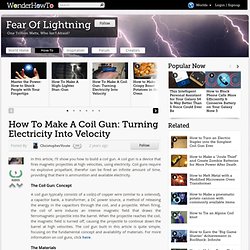

How to turn "water" into marbles. 7 Mad Science Experiments You Can Do At Home But Probably Shouldn’t. By the time you finish reading this article, you will undoubtedly think of Theo Gray when you hear someone say "mad scientist. " Theo, a columnist for the magazine Popular Science, recently published a book titled Theo Gray's Mad Science: Experiments You Can Do At Home - But Probably Shouldn't .
The book is full of experiments so outrageous (Ignite your own phosphorus sun in a globe filled with pure oxygen! Make your own shotgun ammo by pouring molten lead off the roof! Heat a hot tub with 500 pounds of quicklime!) Behind the gorgeous photos of each experiment, there is solid science explained in clear, accessible language with a little dash of humor that made Theo's monthly PopSci column so popular. 1. DISAPPEARING ACT - A steaming cup of water liquefies the spoon in about 15 seconds - notice the puddle at the bottom of the cup. With the right mix of metals, you can make an alloy that turns to liquid at nearly any temperature. and Uncle Tungsten ). How To Create a Melting Spoon 2. 3. The Gizmologists Lair. Windbelt, Cheap Generator Alternative, Set to Power Third World. October 1, 2007 12:00 AM Working in Haiti, Shawn Frayne, a 28-year-old inventor based in Mountain View, Calif., saw the need for small-scale wind power to juice LED lamps and radios in the homes of the poor.

Conventional wind turbines don't scale down well—there's too much friction in the gearbox and other components. "With rotary power, there's nothing out there that generates under 50 watts," Frayne says. So he took a new tack, studying the way vibrations caused by the wind led to the collapse in 1940 of Washington's Tacoma Narrows Bridge (aka Galloping Gertie). Frayne's device, which he calls a Windbelt, is a taut membrane fitted with a pair of magnets that oscillate between metal coils. Frayne hopes to help fund third-world distribution of his Windbelt with revenue from first-world applications—such as replacing the batteries used to power temperature and humidity sensors in buildings. [Project] L3p D3sk - techPowerUp! Forums.
Welcome to Dangerous Laboratories! How To Make A Coil Gun: Turning Electricity Into Velocity « Fear Of Lightning. How To Make A Coil Gun: Turning Electricity Into Velocity In this article, I'll show you how to build a coil gun.

A coil gun is a device that fires magnetic projectiles at high velocities, using electricity. Coil guns require no explosive propellant, therefor can be fired an infinite amount of time, providing that there is ammunition and available electricity. The Coil Gun: Concept A coil gun typically consists of a coil(s) of copper wire (similar to a solenoid), a capacitor bank, a transformer, a DC power source, a method of releasing the energy in the capacitors through the coil, and a projectile.
The Materials You can either make your own coil, or find/buy a solenoid (found online here)A disposable camera, or other DC voltage source over 300 volts. Note: I used a different on/off switch, but any on/off switch works. The Tools Soldering ironHot glue gunWire cuttersExacto knifeScrew drivers (depending on your disposable camera and your soldering iron, you could need Phillips or Flat) Tips.